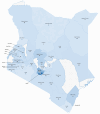Violence against healthcare workers in Kenya: a cross-sectional sub-analysis of the global vishwas study
- PMID: 40065291
- PMCID: PMC11892256
- DOI: 10.1186/s12889-024-20753-w
Violence against healthcare workers in Kenya: a cross-sectional sub-analysis of the global vishwas study
Abstract
Background: Global concern exists for workplace violence against healthcare workers (HCWs), especially in low and middle-income nations. This violence includes physical, verbal, or sexual abuse and has a significant impact despite initiatives like Occupational Safety and Health Administration (OSHA) guidelines. We conducted a study in Kenya to address this issue.
Methods: We did a cross-sectional survey that collected responses during June 6th to August 9th, 2022, focused on healthcare professionals in Kenya within the global ViSHWaS study. Violence against healthcare professionals in multiple Kenyan counties was analysed, The study reached participants through social media, emails, and other channels using a snowball sampling technique.
Results: The survey included 1,458 HCWs, primarily females (66.5%), aged 36-45 (42.4%), and of African race, representing 40 counties, with the majority from Nairobi (28.9%) and working in government academic (35.5%) and private academic institutions (20.6%). Most had over 11 years of healthcare experience (64.4%), and registered nurses were the most common cadre (27.8%). Approximately half of enrolled participants (49.9%) reported experiencing violence, with verbal violence (80.6%) and emotional abuse (78.6%) being common. Online harassment was reported by only 3.5%, mainly on Facebook (63.2%), involving hate speech (92.1%). Patients or their relatives were the most common aggressors (44.7%), while supervisors accounted for 12.5%. The frequency of violence varied, and 80.2% noted an increase after the COVID-19 pandemic. Only 41.2% of incidents were reported. Most were familiar with safety guidelines (93.6%). Self-violence was associated with familiarity with guidelines, concern about violence, preparedness, and night shifts, while colleague violence was associated with age, gender, race, work experience, training, preparedness, and night shifts.
Conclusion: Our Kenya-based cross-sectional sub-analysis highlights that a significant number of HCWs experienced violence, especially during the COVID-19 pandemic, which negatively affected job satisfaction. Although most HCWs were familiar with OSHA guidelines, there were difficulties in their practical implementation.
Keywords: Healthcare workers; Kenya; Nurses abuse; Physician abuse; Violence; Violence against healthcare workers.
© 2024. The Author(s).
Conflict of interest statement
Declarations. Ethical approval and consent to participate: An informed consent was obtained from all the participants. Consent for publication: Not applicable. Competing interests: The authors declare no competing interests.
Figures




References
-
- Guidelines for Preventing Workplace Violence for Health Care and Social Service Workers. U.S. Department of Labor, Occupational Safety and Health Administration; 1996. 60 p.
-
- Liu J, Gan Y, Jiang H, Li L, Dwyer R, Lu K, et al. Prevalence of workplace violence against healthcare workers: a systematic review and meta-analysis. Occup Environ Med. 2019;76(12):927–37. - PubMed
MeSH terms
LinkOut - more resources
Full Text Sources

